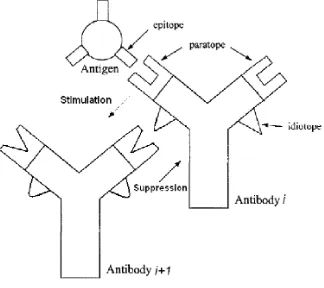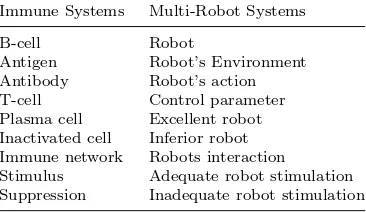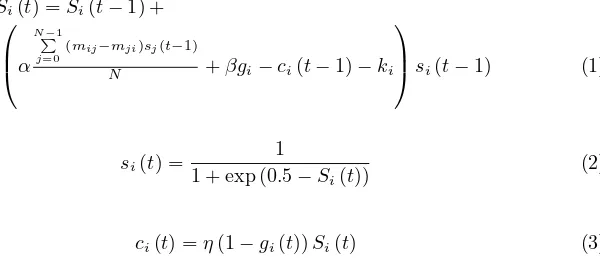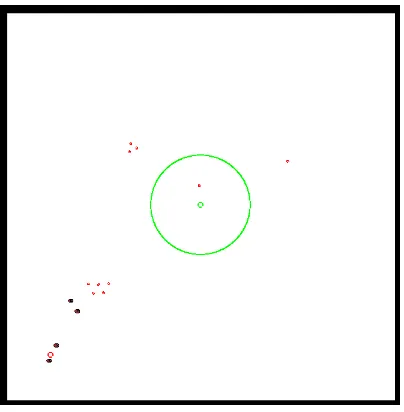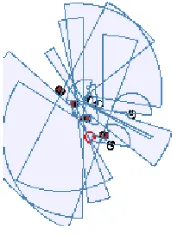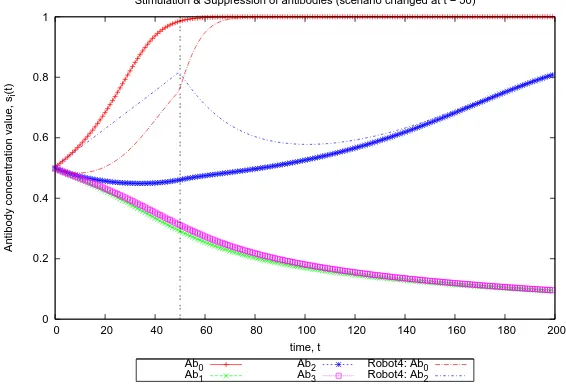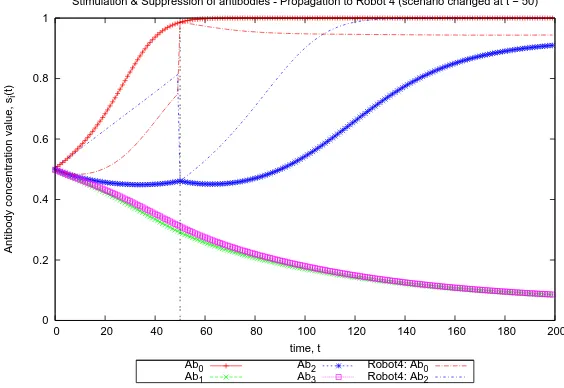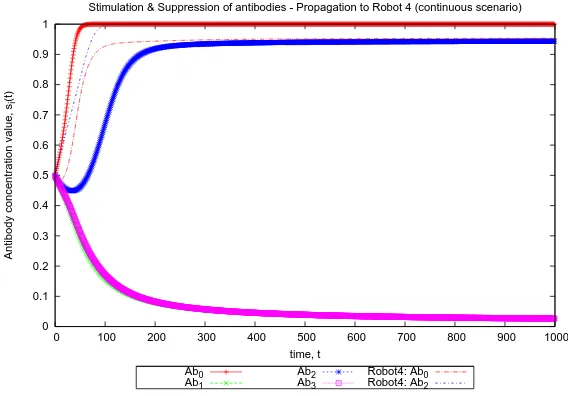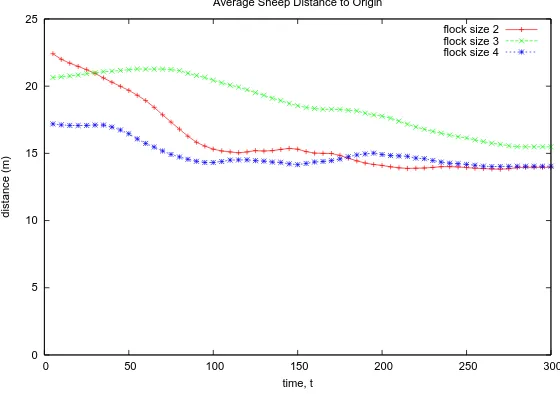c
World Scientific Publishing Company
IMMUNE INSPIRED COOPERATIVE MECHANISM WITH REFINED LOW-LEVEL BEHAVIORS
FOR MULTI-ROBOT SHEPHERDING
SAZALINSYAH RAZALI†,‡,∗
†Faculty of Information & Communication Technology,
Universiti Teknikal Malaysia Melaka, 76100 Durian Tunggal, Melaka, Malaysia
QINGGANG MENG‡and SHUANG-HUA YANG‡ ‡Department of Computer Science,
Loughborough University,
LE11 3TU Loughborough, Leicestershire, United Kingdom
Received 7 May 2011 Revised 31 August 2011
In this paper, immune systems and its relationships with multi-robot shepherding prob-lems are discussed. The proposed algorithm is based on immune network theories that have many similarities with the multi-robot systems domain. The underlying immune inspired cooperative mechanism of the algorithm is simulated and evaluated. The pa-per also describes a refinement of the memory-based immune network that enhances a robot’s action-selection process. A refined model, which is based on the Immune Network T-cell-regulated—with Memory (INT-M) model, is applied to the dog-sheep scenario. The refinements involves the low-level behaviors of the robot dogs, namely shepherds’ formation and shepherds’ approach. These behaviors would make the shepherds to form a line behind the group of sheep and also obey a safety zone of each flock, thus achiev-ing better control of the flock and minimize flock separation occurrences. Simulation experiments are conducted on the Player/Stage robotics platform.
Keywords: memory-based immune systems; immune network; multi-robot cooperation; shepherding.
1. Introduction
Usually mobile robots need to interact and engage with one another in order to achieve assigned tasks more efficiently. These autonomous multi-robot systems would be highly beneficial in assisting humans to complete suitable tasks. In such systems, distributed intelligence is highly needed in the team whereby decisions are processed in each individual robots.1,2 Furthermore, these robots would need to have the mechanism to cooperate so that they would achieve the assigned task.3,4
∗Corresponding author: [email protected] and [email protected]
Biological systems are examples of distributed information processing that are capable of solving problems in living organisms in a distributed manner. These bi-ological systems include neural networks in the brain that is capable of processing information through impulses at the synapses, genetic systems in constructing the organism genes and immune systems which protect and maintain the homeostatic state of the living organism. Biological immune systems are particularly interest-ing, not only because they have no central processing but also exhibit cooperative capability among the antibodies in maintaining the internal stable environment of the body.
This leads to the advances in research on Artificial Immune Systems (AIS) and the application of AIS in engineering fields particularly in Multi-Robot Systems (MRS) domain.1,3,5Situations faced by multi-robot systems require real-time pro-cessing and response. Furthermore, such situations would also require these systems to be robust to changes in the environment and some unexpected events, such as failure of robots in the team. Thus, mimicking the biological immune system is appropriate.
This paper proposes a refinement upon the memory-enhanced immune system algorithm to achieve better shepherding behavior in a team of multiple shepherds. Using the algorithm inspired by the immune network theory, the robots have the capability of performing their task in a dynamically changing environment. The proposed refined algorithm is applied to the dog and sheep scenario.5,6 Simula-tion experiments are arranged to investigate the refinements performance using the stated scenario.
2. Inspiration from Immunology
This section explains the principle of the biological immune response and the Id-iotypic Network Hypothesis which describe the cooperative behavior achieved by immune systems in vertebrate organisms. This is followed by the generic relation between immune systems and multi-robot systems.
2.1. Biological immune systems
Immune system is a system that eliminates foreign substances from an organism’s body. These foreign substances such as bacteria, fungi or virus cells that can harm the host are called pathogens. When such substance activates an immune response it is called antigen, which stimulates the system’s antibody generation. Each type of antigen has a unique set of identification on its surface called epitope. These antigenic determinants are where the host’s antibodies would attach to by using their paratope, as shown in Fig. 1.Antibodies are cells in the immune system that kill antigens in order to maintain the host homeostatic state—i.e. balancing the body’s health status.
Fig. 1. Antigen-antibody binding and Jerne’s Idiotypic Network Theory.
and adaptive immunity. Innate immunity is the first line of defense of the immune system. Generic pathogens that can be recognized and killed by the innate immunity cells would not be able to harm the host further. However, certain disease carrying antigens would bypass this defense mechanism because the innate immunity does not adapt to antigens that originate from various types of illnesses. The adaptive immunity would then play its role through the use oflymphocytes which are gen-erally known as white blood cells. Lymphocytes have two main types,T-cells that mainly help in recognizing antigen cells andB-cells that mainly produce antibodies to fight specific antigens. In humans, T-cells are primarily produced in the thymus while B-cells are produced in bone marrows. These innate and adaptive immune responses make up effective and important defense mechanism for living organisms.
2.2. Biological immune response
The immune response can be described in six general phases of recognition and activation. Pathogen; which are cells from outside of the host organism; is ini-tially digested by Antigen Presenting Cells (APC) where it is broken down into peptides.7 These peptides will then bind to Major Histocompatibility Complex (MHC) molecules, then presented on the APC surface. T-cells recognize these differ-ent APC receptors and thus become activated. They divide and releaselymphokines that transmit chemical signals to stimulate other immune system components to take action. B-cells would then travel to the affected area and be able to recognize the antigen. This would activate the B-cells which then mature intoplasma cells. Plasma cells are the ones which release specific antibody molecules that neutralize the particular pathogens.
fighting antigens that invade the host and the system’s adaptability in responding to various kind of antigens. The B-cells cooperatively merge at the affected area and produce appropriate antibodies for that particular situation. This phase of immune response exhibits cooperative behavior of the related cells.
2.3. Idiotypic network hypothesis
Studies in immunology have suggested that antibodies are not isolated but they ‘communicate’ with each other. Each type of antibody has its specificidiotope, an antigen determinant as shown in Fig. 1. Jerne who is an immunologist proposed the Idiotypic Network Hypothesis (also known as Idiotypic Network Theory) which views the immune system as a large-scale closed system consisting of interaction of various lymphocytes (i.e. B-cells).8,9 Referring to Fig. 1, idiotope of antibodyi stimulates antibody i+1 through its paratope. Antibodyi+1 views that idiotope (belonging to antibody i) simultaneously as an antigen. Thus, antibodyi is sup-pressed by antibodyi+1. These mutual stimulation and suppression chains between antibodies form a controlling mechanism for the immune response.7
Farmer et al. proposed differential equations of Jerne’s idiotypic network theory.10 These equations consist of antibodies’ stimulus and suppression terms, antigen-antibody affinity, and cell’s natural mortality rate. This large-scale closed system interaction is the main mechanism that can be used for cooperation of multi-robot systems.
2.4. Immune systems and multi-robot systems
The relationship of the immune systems with multi-robot systems is evident where obstacles, robots and their responses are antigens, B-cells and antibodies respec-tively. Table 1 lists the parallel terminologies of MRS and immune systems that are being used in this paper.
Table 1. Immune Systems and MRS relationship Immune Systems Multi-Robot Systems
B-cell Robot
Antigen Robot’s Environment Antibody Robot’s action
T-cell Control parameter
Plasma cell Excellent robot Inactivated cell Inferior robot Immune network Robots interaction
Stimulus Adequate robot stimulation Suppression Inadequate robot stimulation
immune network uses affinity measures that are dependent on other cells concen-tration and location in determining the next action. Other than that, multi-robot systems require recognition ability of obstacles and other robots, which is parallel to the immune system recognition and activation phase of an immune response. Obviously, in immune network the processing of information is done in real-time and in a distributed manner—as what a multi-robot system requires.
3. Immune Inspired Multi-Robot Shepherding
3.1. Immune-based swarm behaviors
Sunet al.have proposed a model based on Farmer’s immune network equation that involves T-cells as control parameter which provides adaptation ability in group behavior.11 The advantage of adding the T-cell model is that the system adapts quickly to the environment by recovery of antibody concentration to the initial state, when antigens have successfully been removed. Thus, the system is more adaptable to environmental changes.
The group control or coordination phase is done in a distributed manner via local communication between nearby robots. When a robot encounters other robot and both have the same or similar strategy, this strategy is stimulated; if not, the strategy is suppressed. This facilitates the group to self-organize towards a common action which is optimal for the local environment. If a robot is stimulated beyond a certain threshold—which makes it an excellent robot, its behavior is regarded as adequate in the system such that it can transmit its strategy to other inferior robots. This is a metaphor of the plasma cell in the biological immune systems.
3.2. Multi-robot shepherding problems
The application domain of multi-robot shepherding is complex, as there are many robot shepherds trying to control a constantly moving flock which comprises of several robots. Some of the approach proposed assumes that the shepherds have a global view of the current environment.12,13 However, this assumption makes it not a fully distributed approach. Other than that, usually it is assumed that the shepherds have some a priori information regarding the dynamic situation—such as the total number of robots in the flock.
Another problem is regarding the propagation of local group behavior. Other proposed approaches rely on propagation using one-to-one basis (i.e. during two robots encounter).5,11 To achieve a more precise description of the local neighbor-hood environment, local group behaviors should be propagated within the robots’ local neighborhood radius.
3.3. The INT-M model
activated and multiplied (i.e. proliferate) so that adequate immune response could be mounted later. The activated B-cells will proliferate and differentiate intoPlasma cells that will secrete specific antibodies andMemory cellswhich will be in the host body for quite a long time.7 These memory cells will act as catalysts in mounting a quick immune response to the same antigen in the future.
In order to improve the approach by Sunet al., a specific memory mechanism is proposed in order to retain the appropriate action for relevant environment condi-tion. This mechanism is introduced when the newly sensed environment is similar to the previous environment. Thus, a quick action-selection process can be executed without the need of re-evaluating the new situation.
The approach is named as Immune Network T-cell-regulated—with Memory (INT-M) which involves modeling the memory part of the biological immune systems.14 The general algorithm is shown in Algorithm 1 which is an extension of Sun et al. approach. The algorithm being displayed is for each robot in the group, and uses Eq. (1), (2) and (3).
Si(t) =Si(t−1) +
α
N−1
P j=0
(mij−mji)sj(t−1)
N +βgi−ci(t−1)−ki
si(t−1) (1)
si(t) =
1
1 + exp (0.5−Si(t))
(2)
ci(t) =η(1−gi(t))Si(t) (3)
In Eq. (1), (2) and (3), Si(t) is the stimulus value of antibody i where i, j = 0. . . N,N is the number of antibody types.mij is the mutual stimulus of antibody
i and j, which is detailed in Table 2. gi is the affinity of antibody i and antigen, which can arbitrarily be assigned using a function. A simple step function is used to assign the antigen to antibody affinity values, i.e.gias shown in Table 3.si(t) is the concentration of antibodyi. The difference with Farmeret al.immune network equation is that sj(t) is not the concentration of self-antibody, but that of other robot’s antibody obtained by communication.
Table 2. Mutual stimulus coefficient,mij roboti\robotj Ab0 Ab1 Ab2 Ab3
Aggregation,Ab0 1.0 -0.4 -0.2 -0.4
Search,Ab1 -0.4 1.0 -0.4 -0.2
Dispersion,Ab2 -0.2 -0.4 1.0 -0.4
Algorithm 1Immune Network T-cell-regulated—with Memory (INT-M)
Require: t= 0,Si(0) =si(0) = 0.5 fori= 0. . . N−1,N is number of actions
Ensure: retain previousAbif robot is excellent and environment is similar
Abmax←Ab1, robot←inferior, environment←similar
loop
ExecuteAbmax
if robot6= inferiorthen{robot is activated (i.e. excellent)}
if gi(t)≈gi(t−1)then{environment sensed issimilar to previous} Si(t)←Si(t−1),si(t)←si(t−1),ci(t)←ci(t−1)
else
environment←changed
end if end if
if (robot = inferior)k(environment = changed)then
fori←0 toN−1do
calculateSi(t),si(t) andci(t)
end for
if Si(t)>τ¯ then
robot←excellent
else if Si(t)< τ then
robot←inferior
if robot encounterrobotexcellent then
for allido
receiveAbi and renewsi(t)
end for end if end if end if
if Abi hasmax(si(t))then
Abmax←Abi
end if t←t+ 1
end loop
Table 3. Antigen-antibody affinity stimulus function,gi (other index values remain as 0.0)
Task Detected (%) Task Density givalues
(66 – 100] High g0= 1.0
(10 – 66] Medium g1= 1.0
( 0 – 10] Low g2= 1.0
0 None g2= 1.0,g3= 0.5
and β are parameters of response rate of other robot and the environment (anti-gen) respectively. In biological immune systems, helper T-cells activate B-cells when antigen invades, and suppressor T-cells prevent the activation of B-cells when the antigen has been eliminated thus ensuring that the system adapts quickly to the environment by recovery of antibody concentration to the initial state. The respec-tive values of 0.622 and 0.378 are for the upper (τ) and lower (τ) thresholds based on Eq. (4) and (5), are used in determining whether a robot becomes an excellent (i.e. plasma cell) or an inferior (i.e. inactivated cell) robot.
τ= 1
1 +e−0.5 = 0.622 (4)
τ= 1
1 +e0.5 = 0.378 (5)
3.4. Shepherding test scenario
In this paper we investigate shepherding behavior of robots. Shepherding behavior is similar to a flocking behavior but having agents/robots outside of the flock guiding or controlling the members.12,13It is similar to multiple combat Unmanned Ground Vehicle (UGV) systems scenario.15
A distinct part of this study is that we are looking into the refined low-level behavior of the memory-based immune network cooperation approach by the robots (i.e. dogs) in maintaining the herd (i.e. sheep). This utilizes better shepherding control in addition to the advantage of memory in the action-selection phase.
In a dog and sheep problem, a few dogs try to guide a few sheep to the grazing site (also called the safety zone) without going beyond the borders.6Dogs are required to cooperate in shepherding the sheep which are moving away from the dogs or wandering randomly inside the area. The objective is to herd the sheep into the grazing site while having partial information of what is happening in the area. Fig. 2 shows the screen-shot of the dog and sheep scenario.
Fig. 2. The Dog-Sheep problem environment with four robot dogs at the bottom-left corner while the smaller robots are the sheep—the grazing site is at the middle of the enclosed field and the bottom-left circle is to mark the robot dogs’ start position.
dogs also uses the Vector Field Histogram (VFH+) algorithm provided in the simu-lation platform for obstacle avoidance and goal-seeking behaviors, i.e searching for the shepherds’ positions with respect to the herd.16
3.5. INT-M refinement
Multiple shepherds pose a few underlying problems regarding the interaction be-tween the shepherds and the flock.13 The proposed refinement of the INT-M model is focused only on the Shepherds’ Formation and Shepherds’ Approach aspects. This refinement is then applied onto the dog and sheep scenario.
The formation involves the robot dogs to line-up behind the group of sheep so that the flock can be better controlled. The approach is also refined as in when a robot dog move towards a sheep it will obey the safe zone of that sheep, so that the sheep would not be influenced by the incoming dog. This will achieve a lower flock separation occurrences, thereby having better shepherding behavior. Fig. 3 is the depiction of the proposed refinement of the model by having the robot dogs forming a line behind the group of sheep.
4. Immune Network Inspired Cooperative Mechanism
Fig. 3. An example of the refinement of low-level shepherding behavior: robot dogs lining-up (the grazing site is located at the top-right corner).
robots. Simulation experiments were conducted to verify the proposed cooperation mechanism.
The values for the constants are α = 0.0, β = 0.05 η = 0.05 and k = 0.002 which follows Sunet al.values, except forη which is our own value.11 At the start of simulations, the values for gi are set to 0.0 except for g2 (Dispersion) and g3 (Homing) are assigned 1.0 and 0.5 respectively.
Robot 4 starts with not seeing any of the tasks (i.e. percentage of tasks detected is 0.0%), although assumption is made that all robots are within each others’ com-munication range. This may happen for instance when robot 4 is facing another direction from the rest of the group. Meanwhile, the other robots are assumed to have already detected 75.0% of the task at start time. Furthermore, it is assumed that all robots remain geographically static over time.
Fig. 4–7 display the average for each antibodies’ concentration value (i.e. si) over time that was run for several times. The antibody (i.e. strategy) with the highest concentration (i.e. maximum value) ofsiwill be selected by the robot to be executed.
4.1. Response to environmental changes
In order to test the response of robot 1–3 towards changes in its environment, all of the robots’ tasks detected values are changed to 0.0% att= 50. Fig. 4 shows the effects of this, whereby slower increase of robot 1–3Ab2(Dispersion) value and the gradual decrease of their Ab0 (Aggregation) value can be seen. This is due to the fact that only robot 4 is influencing this behavior to the other three robots.
0 0.2 0.4 0.6 0.8 1
0 20 40 60 80 100 120 140 160 180 200
Antibody concentration value, s
i
(t)
time, t
Stimulation & Suppression of antibodies (scenario changed at t = 50)
Ab0
Ab1
Ab2
Ab3
Robot4: Ab0
Robot4: Ab2
Fig. 4. Ab0toAb3are the average of robot 1–3, which start with high task density then changed
to 0 density att= 50.
0 0.2 0.4 0.6 0.8 1
0 20 40 60 80 100 120 140 160 180 200
Antibody concentration value, s
i
(t)
time, t
Stimulation & Suppression of antibodies (scenario changed at t = 50)
Ab0
Ab1
Ab2
Ab3
Robot4: Ab0
Robot4: Ab2
Fig. 5. Ab0toAb3are the average of robot 1–3, robot 4 starts with 0 task density then changed
to detect 75.0% of the task (like the other robots) att= 50.
4.2. Propagation of stimulation and suppression of antibodies
behavior is propagated within the neighborhood. In Fig. 6 robot 4 gradually becomes Excellent, then at t = 50 it is set to be Inferior. The figure shows that in almost instantly robot 4 receives the ‘better’ strategy (Aggregation,Ab0) from the other robots. However, since its local task detected remains 0.0%,Ab2is still stimulated. Robot 4 eventually becomes Excellent again and thus selectsAb2(Dispersion) once more—as it would much more ‘believe’ what it can sense. This happens att≈110 as shown in Fig. 6.
0 0.2 0.4 0.6 0.8 1
0 20 40 60 80 100 120 140 160 180 200
Antibody concentration value, s
i
(t)
time, t
Stimulation & Suppression of antibodies - Propagation to Robot 4 (scenario changed at t = 50)
Ab0
Ab1
Ab2
Ab3
Robot4: Ab0
Robot4: Ab2
Fig. 6. Robot 4 becomes Excellent over time, then changed to be Inferior at t = 50 thus almost instantaneously receives the strategy (i.e.Ab) from the other robots—which in this case is Ab0
(Aggregation)—but later changed back as it returns to be Excellent once again.
Fig. 7 shows as robot 4 gradually becomes Excellent, it continues to choose (i.e. ‘believe’)Ab2 (Dispersion) strategy—which is suited to its locally sensed environ-ment (i.e. no task detected). It remains to focus on it’s locally sensed environenviron-ment, however its Ab0 (Aggregation) is highly stimulated because of the propagation of this strategy from the other robots. The other robots’ Ab2 strategy is also stimu-lated.
5. Simulation Experiments
0 0.1 0.2 0.3 0.4 0.5 0.6 0.7 0.8 0.9 1
0 100 200 300 400 500 600 700 800 900 1000
Antibody concentration value, s
i
(t)
time, t
Stimulation & Suppression of antibodies - Propagation to Robot 4 (continuous scenario)
Ab0
Ab1
Ab2
Ab3
Robot4: Ab0
Robot4: Ab2
Fig. 7. Over time, robot 4 becomes Excellent and continues to do so as the environment has not changed—thus it maintains it’s strategy ofAb2 (Dispersion). At the same time, itsAb0 strategy
is highly stimulated via propagation by other robots.
5.1. Simulation setup
The range for the robot dogs are set to five meters for forward sight (i.e. laser) and 20 meters for emulating sense of hearing. The field is constructed of a walled field with the size of 40 meters each side. The grazing site is situated at the center with a radius of five meters and each sheep that have entered it will stop. Each experiment is limited to a limit of five minutes (i.e. 300 seconds — used in Figs. 8 and 9) and it is done for six times, then the average values are calculated.
5.2. Performance criteria
The performance can mainly be measured on two aspects. The average distance of the flock that is shepherd into the grazing site (which is known as Average Distance to Origin), and also the average percentage of sheep left in the field (which is known as Average Incomplete Tasks) after the maximum time is up. The average percentage of incomplete tasks criterion signifies the ability to maintain the balance of the overall goal of shepherding all the sheep and also completing it within the specified time.
5.3. Simulation results
contained within the flock. This reflects on the refinements applied to the dogs’ shepherding behavior. Furthermore, the average distance of flocks with four sheep is quite stable over time. However, flocks of size two do show a relatively smoother transition over time—indicating that the flock is quite manageable.
0 5 10 15 20 25
0 50 100 150 200 250 300
distance (m)
time, t
Average Sheep Distance to Origin
flock size 2 flock size 3 flock size 4
Fig. 8. Average Distance to Origin.
Fig. 9 shows the average percentage of sheep still outside of the grazing site over time. The figure suggests that in average there will at least be some sheep that can be shepherd into the grazing site, because after the time is up all of the flock sizes have less than 80% of incomplete tasks remaining. Nonetheless, the average incomplete tasks percentage for all flock sizes are not less than 60%. In general, flocks of size two can achieve lower incomplete task rate within the time limit. On the other hand, flocks with four sheep display quicker response that might indicate a trend.
6. Conclusions
50 60 70 80 90 100
0 50 100 150 200 250 300
average percentage of sheep (%)
time, t
Average Percentage of Sheep Outside Grazing Site
flock size 2 flock size 3 flock size 4
Fig. 9. Average Incomplete Tasks.
carried out to evaluate the cooperative mechanism and the whole approach. The approach can be extended to other application domains which require sev-eral agents (robots) to work cooperatively in a distributed way in a dynamic envi-ronment. It can further be implemented on real robots such as the e-pucks to obtain the algorithm performance in real world situation.18
Acknowledgments
Mr. Razali gratefully acknowledges Malaysian Ministry of Higher Education and Universiti Teknikal Malaysia Melaka (UTeM) for sponsoring his PhD study.
References
1. L. E. Parker, ALLIANCE: an architecture for fault tolerant multirobot cooperation,
IEEE Trans. Robot. Autom.14(2) (1998) 220–240.
2. L. E. Parker, Distributed intelligence: overview of the field and its application in multi-robot systems,J. Phy. Ag.2(1) (2008) 5–14.
3. Y. U. Cao, A. S. Fukunaga and A. Kahng, Cooperative mobile robotics: antecedents and directions,Auton. Robot.4(1) (1997) 7–27.
4. A. M. Khamis, M. S. Kamil and M. A. Salichs, Cooperation: concepts and general typology, inProc. IEEE International Conference on Systems, Man, and Cybernetics, (Taipei, Taiwan, 2006), pp. 1499–1505.
6. A. Schultz, J. J. Grefenstette and W. Adams, Roboshepherd: Learning a complex behavior,Robot. Manuf.: Recent Trends in Res. and Appl.6(1996) 763–768. 7. L. N. de Castro and J. Timmis,Artificial Immune Systems: A New Computational
Intelligence Approach(Springer, 2002).
8. N. K. Jerne, Towards a network theory of the immune system, Ann. Immunol.
125C(1–2) (1974) 373–389.
9. N. K. Jerne, Idiotypic networks and other preconceived ideas,Immunol. Rev.79(1) (1984) 5–24.
10. J. D. Farmer, S. A. Kauffman, N. H. Packard and A. S. Perelson, Adaptive dynamic networks as models for the immune system and autocatalytic sets,Ann. N. Y. Acad. Sci.504(1) (1987) 118–131.
11. S.-J. Sun, D.-W. Lee and K.-B. Sim, Artificial immune-based swarm behaviors of distributed autonomous robotic systems, inProc. IEEE International Conference on Robotics and Automation (ICRA’01),4, (Seoul, Korea, 2001), pp. 3993–3998. 12. J.-M. Lien, O. B. Bayazit, R. T. Sowell, S. Rodriguez and N. M. Amato,
Shepherd-ing behaviors, in Proc. IEEE International Conference on Robotics and Automation (ICRA’04),4, (New Orleans, USA, 2004), pp. 4159–4164.
13. J.-M. Lien, S. Rodriguez, J. Malric and N. M. Amato, Shepherding behaviors with multiple shepherds, inProc. IEEE International Conference on Robotics and Automa-tion (ICRA’05), (Barcelona, Spain, 2005), pp. 3402–3407.
14. S. Razali, Q. Meng and S.-H. Yang, Multi-robot cooperation using immune network with memory, inProc. 7th IEEE International Conference on Control and Automation (ICCA’09), (Christchurch, New Zealand, 2009), pp. 145–150.
15. L. Weng, W. Cai, R. Zhang, M. Bikdash and Y. D. Song, Immunology-inspired swarm coordination with application to multiple combat UGV systems, inProc. 7th World Congress on Intelligent Control and Automation, (Chongqing, China, 2008), pp. 3293– 3298.
16. I. Ulrich and J. Borenstein, VFH+: Reliable obstacle avoidance for fast mobile robots, in Proc. IEEE International Conference on Robotics and Automation (ICRA’98), (Leuven, Belgium, 1998), pp. 1572–1577.
17. B. Gerkey, R. T. Vaughan and A. Howard, The player/stage project: Tools for multi-robot and distributed sensor systems, inProc. 11th International Conference on Ad-vanced Robotics (ICAR’03), (Coimbra, Portugal, 2003), pp. 317–323.
